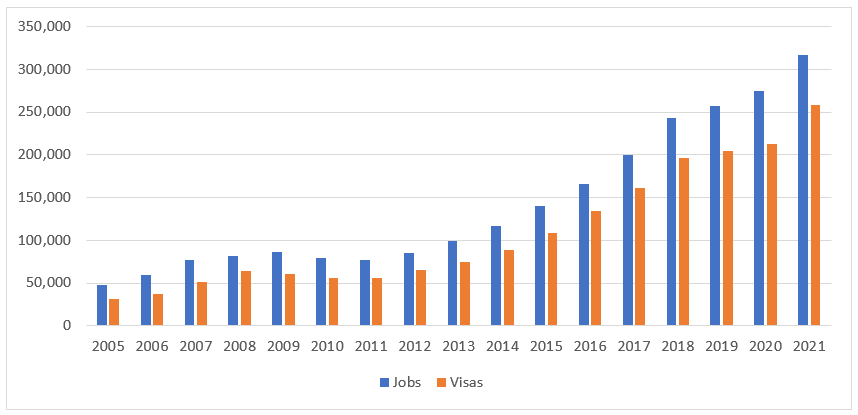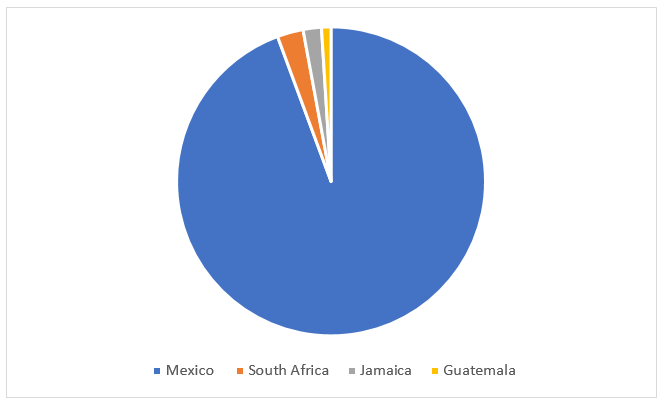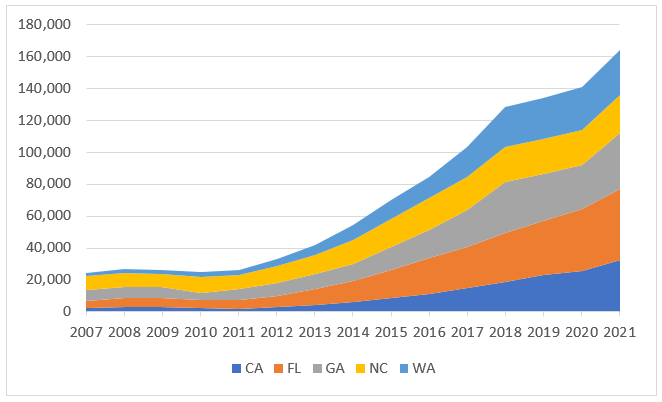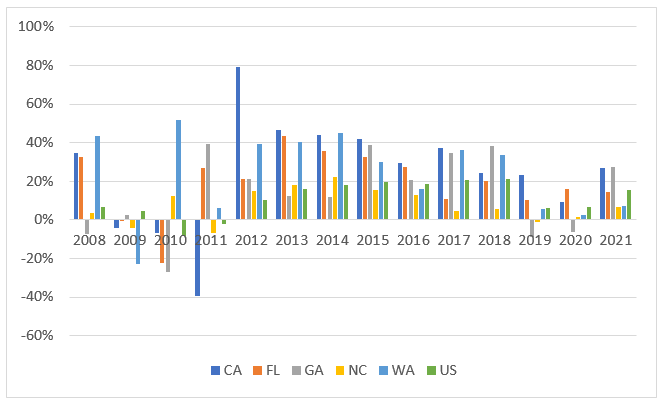A Look at H-2A Growth and Reform in 2021 and 2022.
Fiscal Year 2021 brought a record number of migrants on H-2A Visas to the United States. Dr. Philip Martin provides demographic analysis of these visa recipients, and provides suggestions on how to improve H2-A regulations in the coming years.
In, FY21, the Department of Labor (DOL) certified over 317,000 seasonal farm jobs to be filled by H-2A workers, up 15 percent from 275,000 in FY20, and more than three times the 100,000 jobs certified in FY13.
About 80 percent of H-2A jobs that were certified resulted in the issuance of H-2A visas, some 258,000 in FY21, including a peak 40,000 in March, 36,000 in April, and 34,000 in May. These three months accounted for 110,000 or 43 percent of H-2A visas issued.
H-2A visas are issued to citizens of countries from Argentina to Zimbabwe, but 99 percent went to citizens of four countries: Mexico, 93 percent, South Africa, three percent, Jamaica, two percent, and Guatemala, one percent. El Salvadorans received fewer than 300 H-2A visas and Hondurans fewer than 500, while Nicaraguans received almost 800 H-2A visas.
DOL certifies employers to fill over 97 percent of the jobs they want to fill with H-2A workers. H-2A workers are in the US an average of six months, which means they filled about 125,000 year-round equivalent jobs, 11 percent of the 1.1 million FTE jobs in US crop agriculture. Braceros at their peak in the mid-1950s, when 455,000 were admitted, accounted for almost 20 percent of the peak 2.5 million hired farm workers at that time.
Over half of H-2A jobs are in five states: California, Florida, Georgia, North Carolina, and Washington. The share of H-2A jobs in these five states rose from 34 percent in 2007 to 52 percent in 2021 due to the growth in each state and especially in California and Washington, states where the number of jobs certified rose by 14-fold and 15-fold, respectively.
The number of H-2A jobs certified rose by 21 percent between FY19 and FY20 and again between FY20 and FY21. The sharpest year-to-year jump in H-2A job certifications was in CA between FY11 and FY12, up 79 percent, followed by WA’s 52 percent jump between FY09 and FY10. The sharpest year-to-year drop in job certifications was in CA between FY10 and FY11.
California and Washington accounted for five percent of H-2A jobs certified in 2007, and 19 percent in 2021. California accounts for a third of US farm worker employment and Washington 10 percent. H-2A growth may be concentrated in these states.
Jobs: There is no count of US farm jobs, defined as one worker employed by one employer for a period of time that ranges from a few weeks to year round. The Census of Agriculture found that 513,100 US farms had $31.6 billion in expenses for directly hired workers in 2017, and 195,800 US farms (often the same farms) reported $7.6 billion in contract labor expenses, for total farm labor expenses of $39.2 billion.
Many farms that report labor expenses in the COA pay their relatives to assist with farm work to shift farm income into lower tax brackets, but do not report and pay taxes on these wages to state unemployment insurance agencies. The Quarterly Census of Employment and Wages obtains data from farm employers when they report their employment and wages to pay unemployment insurance taxes. QCEW employment data are the number of unique workers on the payroll for the pay period that includes the 12th of the month. Since most farm worker payrolls are weekly, QCEW employment is typically employment during the second week of the month.
UI coverage varies by state, from universal in CA and WA but only for employers who hire 10 or more workers in a quarter, or who pay $20,000 or more in wages during a quarter, in many states. BLS estimates that the QCEW covers 80 percent of farm worker employment.
The QCEW reports far fewer farm employers (establishments), about 105,000 in 2017 versus over 500,000 in the COA, but more wages paid, $44 billion in 2017 versus $39 billion in the COA.
What is the relationship between farm jobs and farm workers? The COA reported 2.4 million directly hired workers in 2017, including two-thirds who were employed on the responding farm for less than 150 days. In COA data, a worker employed on two farms is counted twice, and workers brought to farms by FLCs are not counted, although payments to FLCs are included in contract labor expenses.
The QCEW reported an average 1.3 million jobs in agriculture in 2017, including a peak of 1.4 million in July and a trough of 1.1 million in January. California, which has universal UI coverage, extracted all SSNs reported by farm employers, compiled the farm and nonfarm jobs of these farm workers, and found that there were two unique workers (after adjusting for obviously false SSNs) for each average QCEW job, so that 850,000 unique workers filled the state’s average 425,000 agricultural jobs.
If the California ratio of two workers per year-round job is applied nationally, the US has 2.6 million unique workers to fill the average 1.3 million US farm jobs. About two million of these workers are in crop agriculture and 600,000 in animal agriculture.
Reform: The H-2A program was created by IRCA in 1986 and has been the subject of reform efforts since. East Coast farmers who employed Caribbean workers under the pre-IRCA H-2 program were generally satisfied with the pre-1986 certification, housing, and AEWR requirements of the H-2 program. However, West Coast growers who feared that union workers would apply for jobs they wanted to fill with guest workers wanted a free-agent alternative to the H-2A program.
The compromise in IRCA was the Special Agricultural Worker program that legalized 1.1 million unauthorized foreigners, including many who had not done qualifying farm work. A New York Times article called the SAW program “one of the most extensive immigration frauds ever perpetrated against the United States Government.”
SAW legalization was expected to increase farm labor costs as farmers raised wages to retain newly legalized SAWs or built housing for H-2A workers. Instead, farm labor costs fell as illegal Mexico-US migration surged, so that half of US crop workers were unauthorized by the mid-1990s. The share of SAWs among crop workers fell to less than 15 percent.
Farmers tried to persuade Congress to enact a free-agent guest worker program during the 1990s, but President Clinton threatened to veto any new farm guest worker bill. However, after the election of Mexican President Fox and US President Bush in 2000, worker advocates and growers negotiated AgJOBS, a proposal that would have repeated IRCA’s approach, viz, legalize unauthorized farm workers and make it easier for farmers to hire legal guest workers.
Under AgJOBS, newly legalized farm workers would have had to continue to do farm work in order to become immigrants. Two guest worker programs were proposed, the traditional H-2A program with recruitment and housing requirements, and a new free-agent program without recruitment and housing obligations. Most farm worker advocates and farm employers supported AgJOBS, which was included in the 2006 and 2013 comprehensive immigration reform bills that were approved by the Senate but not the House, so AgJOBs did not become law.
The Farm Workforce Modernization Act, approved by the House in March 2021, would legalize unauthorized farm workers and require them do farm work for at least four more years. Barriers to H-2A workers would be reduced and dairy and other year-round farm jobs would be open to H-2A workers for the first time, but farm employers would still have to provide housing to guest workers. All farm employers would have to use E-Verify to check the status of new hires.
3 Ideas: Despite proposed changes in 2008-09 and 2019-20, DOL has not changed H-2A regulations significantly since IRCA. The fact that few jobless US workers filled seasonal farm jobs despite high unemployment rates during the COVID-19 pandemic in 2020 and 2021 suggests that most of the seasonal hand workers of tomorrow are growing up today somewhere outside the US.
Three changes to the current H-2A program could benefit employers and workers: multi-year certification and visas, turn-key crews, and fewer and larger recruiters.
First, after one or two years in the program, A-rated employers and returning migrant workers could receive multi-year certification and multi-year visas so that both could plan for future employment. A-rated farm employers could presume that their job orders would be certified if they change only the wage rate, number of workers, and start and stop dates.
A-rated workers with multi-year visas could skip the US consulate and leave for jobs abroad from nearer their homes and enter the US. By showing the current job offer that includes employer contact information at ports of entry so that CBP could contact the employer to ensure the job offer is valid. Multi-year visas would allow H-2A workers to fly to US jobs instead of first travel by bus to the US consulate in Mexico and then by bus to the US workplace.
Longer-term certification for A-rated employers and workers would provide more certainty for employers and give workers an incentive to learn English and undergo training to improve their productivity and earnings while employed in the US. Workers could become more familiar with their contracts and employers, so there would be fewer opportunities for recruiters to take advantage of workers.
Second, expanded reliance on returning H-2A workers could lead to new business models, such as organizing crews of workers in sending countries who arrive with supervisors, drivers, cooks and other support personnel, turning labor migration into a turn-key operation for both workers and employers. Custom combining of grain provides an example. Canadian-and US-based firms move equipment, operators, drivers and mechanics from New Mexico and Texas to Canadian prairie provinces, harvesting wheat and other grains with modern equipment from south to north. Harvest workers maximize their seasonal earnings by working from May through October.
Extending this turn-key crew approach to hand-harvested commodities could mean recruiting and training crews in sending countries so that they arrive experienced and ready to work, although equipment may not cross the border. A crew-based approach could take advantage of migrant networks to maintain efficient workforces, recruiting additional workers and training them in the country of origin.
Third is improving recruitment in sending countries. The major issue is an excess supply of workers seeking higher wage jobs abroad, which allows recruiters to charge workers for access to foreign jobs. The ILO and many national governments obligate employers to pay all or most costs for migrant workers, but policing this employer-pays-all-costs requirement in the rural areas where many migrants live is very difficult.
Rather than subsidizing government agencies to create work-ready pools that allow employers to select individual workers, as the US government is doing in Northern Triangle countries, a better approach may be to encourage multinational staffing firms with standards to protect migrant workers to handle more recruitment.
Larger recruiters can afford to invest in systems to screen and train crews of workers, hire staff with language and cultural competencies who understand both the workers and the work, and achieve economies of scale in recruitment. Multi-year certification and multi-year visas reduce costs and worker vulnerability during recruitment, while longer time horizons for recruiters should increase investment in a reputation that recruiters want to protect with compliance.
The net effect of multi-year certification and visas, work-ready crews, and fewer and larger recruiters could be to transform the H-2A program from over 15,000 applications each requesting 20 H-2A workers to fewer and larger firms that request more workers. If these fewer and larger recruiters develop procedures to comply with labor laws and regulations, DOL can more efficiently process applications and enforce compliance while recruiters achieve economies of scale. Multi-year crew-based work schedules organized by fewer and larger recruiters could generate the win-win outcomes long sought by employers and workers as well as labor-sending and -receiving governments.
Outlook: The H-2A program appears poised to continue expanding in 2022 despite a six percent increase in the AEWR to an average $15.56; the AEWR ranges from a low of $12 in the southeastern states to about $17.50 in CA, OR, and WA. Farm employers are seeking changes to the FWMA in the Senate that could slow the increase in AEWRs. Such changes could be opposed by worker advocates, reducing prospects for a legalization and modified H-2A program.
As the Congressional debate continues, more farm employers (including labor contractors) are building housing in order to employ H-2A workers. At the same time, sharp increases in farm labor costs are accelerating efforts to change farming systems in ways that facilitate labor-saving mechanization and encouraging more imports of fresh fruits and vegetables from abroad, especially from Mexico, the source of half of US fresh fruit and three-fourths of US fresh vegetable imports.











